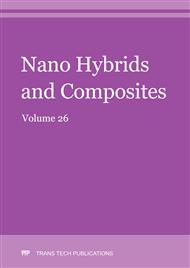[1]
M.H. Sharqawy, S.M Zubair, Efficiency and optimization of straight fins with combined heat and mass transfer –an analytical solution, Appl. Therm. Eng., 28, (2008) 2279-2288.
DOI: 10.1016/j.applthermaleng.2008.01.003
Google Scholar
[2]
S. Sabaghi, A. Rezaii, Gh.R Shahri, M.S Baktash, Mathematical analysis for the efficiency of a semi-spherical fin with a simultaneous heat and mass transfer". Int. J. Refrig, 34, (2011) 1877-1882.
DOI: 10.1016/j.ijrefrig.2011.06.014
Google Scholar
[3]
A. Aziz, M.N Bouaziz, A least squares method for a longitudinal fin with temperature dependent internal heat generation and thermal conductivity, Energ. Conver. Manag., 52, (2011) 2876-2882.
DOI: 10.1016/j.enconman.2011.04.003
Google Scholar
[4]
M.N Bouaziz, S. Hanini, Efficiency and optimisation of fin with temperature-dependent thermal conductivity: a simplified solution, Heat and Mass Transfer, 44 (1), (2007) 1-9.
DOI: 10.1007/s00231-006-0225-4
Google Scholar
[5]
D.D Ganji, Z.Z Ganji, H.D Ganji, Determination of temperature distribution for annual fins with temperature-dependent thermal conductivity by HPM, Therm. Sci., 15, (2011) 111-115.
DOI: 10.2298/tsci11s1111g
Google Scholar
[6]
S. Kiwan, Effect of radiative losses on the heat transfer from porous fins, Int. J.Therm. Sci. , 46, (2007) 1046-1055.
DOI: 10.1016/j.ijthermalsci.2006.11.013
Google Scholar
[7]
S. Kiwan, O. Zeitoun, Natural convection in a horizontal cylindrical annulus using porous fins, Int. J. Numer. Heat Fluid Flow, 18, (2008) 618-634.
DOI: 10.1108/09615530810879747
Google Scholar
[8]
S. Kiwan, M. Al-Nimr, Using porous fins for heat transfer enhancement, Journal of Heat Transfer, 123 (4), (2001) 790-795.
DOI: 10.1115/1.1371922
Google Scholar
[9]
S. Saedodin, S. Sadeghi, S., Temperature distribution in long porous fins in natural convection condition, Middle-east J. Sci. Res., 13 (6), (2013) 812-817.
Google Scholar
[10]
M. Hatami, A. Hasanpour, D.D Ganji, Heat transfer study through porous fins (Si3N4 and Al) with temperature dependent heat generation, Energ. Convers. Manag., 74, (2013) 9-16.
DOI: 10.1016/j.enconman.2013.04.034
Google Scholar
[11]
M. Hatami, D.D Ganji, DD., Investigation of refrigeration efficiency for fully wet circular porous fins with variable sections by combined heat and mass transfer analysis, Int. J. Refrig., 40, (2014) 140-151.
DOI: 10.1016/j.ijrefrig.2013.11.002
Google Scholar
[12]
M. Hatami, Gh.R Mehdizadeh Ahangar, D.D Ganji, K. Boubaker, Refrigeration efficiency analysis for fully wet semi-spherical porous fins, Energ. Conver. Manag., 84, (2014) 533-540.
DOI: 10.1016/j.enconman.2014.05.007
Google Scholar
[13]
D. Bhanja, B. Kundu, B., Thermal analysis of a constructal T-shaped porous fin with radiation effects, International Journal of refrigeration, 34(6), (2011) 1483-1496.
DOI: 10.1016/j.ijrefrig.2011.04.003
Google Scholar
[14]
B. Kundu, B., Bhanja, An analytical prediction for performance and optimum design analysis of porous fins, Int. J. Refrigeration, 34, (2011) 337-352.
DOI: 10.1016/j.ijrefrig.2010.06.011
Google Scholar
[15]
A. Moradi, T. Hayat, A. Alsaedi, Convection-radiation thermal analysis of triangular porous fins with temperature-dependent thermal conductivity by DTM, Energ. conver. Manag, 77, (2014) 70-77.
DOI: 10.1016/j.enconman.2013.09.016
Google Scholar
[16]
R. Das, R., Forward and inverse solution of a conductive-convective and radiative cylindrical porous fin, Energ. Conver. Manag. , 87, (2014) 96-106.
DOI: 10.1016/j.enconman.2014.06.096
Google Scholar
[17]
W. Wen-Jyi, C. Cha'o-Kuang, Transient response of a spiral fin with its base subjected to a sinusoidal form in temperature, Computers & Structures, 34(1), (1990) 161-169.
DOI: 10.1016/0045-7949(90)90310-x
Google Scholar
[18]
P. Kiatpachai, S. Pikulkajorn, S. Wongwises, Airside performance of serrated welded spiral fin-and-tube heat exchangers, International Journal of Heat and Mass Transfer, 89, (2015) 724-732.
DOI: 10.1016/j.ijheatmasstransfer.2015.04.095
Google Scholar
[19]
H. Fajiang, C. Weiwu, Y. Ping, Experimental Investigation of Heat Transfer and Flowing Resistance for Air Flow Cross over Spiral Finned Tube Heat Exchanger, Energy Procedia, 17, (2012) 741-749.
DOI: 10.1016/j.egypro.2012.02.166
Google Scholar
[20]
A.S. Nehad, I.L. Animasaun, R.O. Ibraheem, H.A. Babatunde, N. Sandeep, I. Pop, Scrutinization of the effects of Grashof number on the flow of different fluids driven by convection over various surfaces, Journal of Molecular Liquids, 249 (2018), 980-990.
DOI: 10.1016/j.molliq.2017.11.042
Google Scholar


